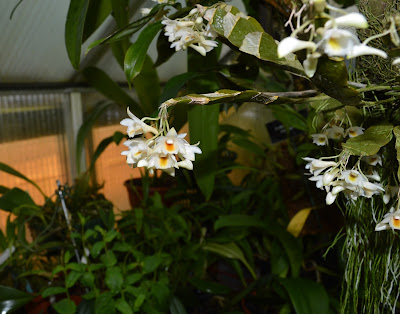Dendrobium platygastrium is native to New Guinea, Solomon Islands, Fiji, New Caledonia and Vanuatu. They grow in open forests with moss and ferns below 300 m. In New Caledonia they grow in dense, damp forests near rivers and waterfalls, from sea level up to 200 m...
Dendrobium platygastrium also called as The Broad-Bellied Dendrobium, Callista platygastria, Dendrobium camptocentrum, Dendrobium goldfinchii, Dendrobium platycaulon, Eurycaulis camptocentrus, Eurycaulis platygastrius, Pedilonum camptocentrum, Pedilonum platygastrium, is a species of the genus Dendrobium. This species was described by Heinrich Gustav Reichenbach in 1878.
IDENTIFY DENDROBIUM PLATYGASTRIUM
Dendrobium platygastrium is native to New Guinea, Solomon Islands, Fiji, New Caledonia and Vanuatu. They grow in open forests with moss and ferns below 300 m. In New Caledonia they grow in dense, damp forests near rivers and waterfalls, from sea level up to 200 m. Though they are found in a vast area, these are rare plants.
It is a miniature sized, hot to cool growing, epiphytic species, which reaching a size of 13-23 cm, with erect, clustered, flattened and club-shaped towards the apex, basally narrow, 10-15 cm long stems enveloped by leaf sheaths carrying 2 to 8, oval, thin, medium green, deciduous, 6-11 cm long leaves.
The Broad-Bellied Dendrobium blooms in the spring and again in the fall on a terminal or lateral, 3 to 6 cm long, erect, few flowered, racemose inflorescence that arises from the nodes near the apex of leafed and leafless canes with non-resupinate flowers. The flowers are 2.0-2.5 cm in diameter and are barely open. They hang, and the lip is directed upwards. The petals of both whorls are white or white with a pinkish tinge. With age, they acquire a purple color. The dorsal petal is straight, oval to oval-elliptical and has a sharp tip. The side flakes spread out slightly, are oval and bent near the apex. The inner whorls are longitudinal-oval, straight and have rounded corners. The lip is white with a deep-yellow throat. The middle plot has a wide top with 5 parallel, slightly protruding stripes. They can self-pollinate.
DENDROBIUM PLATYGASTRIUM CARE AND CULTURE
Cultural information should only be used as a guide, and should be to be adapted to suit you. Your physical location; where you grow your plants, how much time you have to devote to their care, and many other factors, will need to be taken into account. Only then can you decide on the cultural methods that best suit you and your plants.
Light:
Dendrobium platygastrium needs a light level of 15000-25000 lux.
Temperature:
The average temperature of the summer day is 29-30 ° C, night 21-23 ° C, giving a daily difference of 7-9 ° C. In winter the average day temperature is 24-26 ° C, night 16-18 ° C, with a daily difference of 7-8 ° C.
Humidity:
The Broad-Bellied Dendrobium needs the humidity of 70-75% throughout the year.
Substrate, growing media and repotting:
This species can be grown mounted on tree-fern rootstocks or cork as long as we can provide high humidity and watering in summer at least once a day. They can also grown in pots with any loose, quickly drying substrate. Old pseudobulbs continue blooming for many years and should not be removed when repotting.
Watering:
In nature habitat, precipitation is relatively small, and the amount is almost the same for most of the year. The most dry season is late winter and spring, and the richest rainfall occurs in late summer and early autumn. Dendrobium platygastrium should dry a little between watering, but they can never be completely dry.
Fertilizer:
Weekly 1/4-1/2 doses are recommended. From spring to mid-summer should be used fertilizer enriched with nitrogen, and then until the end of autumn fertilizer enriched with phosphorus.
Rest period:
During winter, the amount of water and fertilization should be reduced, and the Dendrobium platygastrium should dry more than in the summer. However, they should not stay dry for too long.















COMMENTS